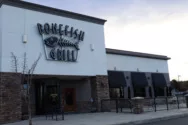
Home » ‘Perfect storm’ of factors hits Washington apple farmers, driving bankruptcies, consolidation
‘Perfect storm’ of factors hits Washington apple farmers, driving bankruptcies, consolidation
Trump’s 2018 tariffs are among the developments that undercut state’s apple market, devastating small farmers

January 6, 2025
A perfect storm of economic challenges is pushing Washington apple farmers out of business.
Small orchardists say they are unable to sustain losses for years on end amid economic conditions they feel will only continue to worsen. The closures are fueling a wave of private equity-backed farmland consolidation.
The trend is the result of an ever-constricting web of factors. They include rising labor costs and stagnant prices paid to farmers, but also dramatic apple oversupply caused by increased farm efficiency and the loss of major international markets due to then-President Donald Trump’s 2018 tariffs.
Those converging conditions afflict farmers who produce Washington’s most valuable crop, which supplies nearly 7 in 10 apples eaten around the U.S. and is worth about $2 billion a year.
Consolidation
Following in his father and grandfather’s footsteps, Tim Calhoun runs a midsized orchard and fruit distribution company in the Yakima Basin near Wapato.
The area is home to about a third of Washington’s 188,000 acres of apple orchards. Neat rows blur into the distance, where Mount Rainier’s foothills rise up to meet a sky that’s almost always blue.
Walking through his family’s orchard at the end of the last harvest in October, Calhoun, 41, explained the industry is in the worst spot he has ever seen it.
“Why the larger companies keep getting larger and larger and larger and larger is because the margins in farming are shrinking every year for the last 40 years,” he said.
Since his family started farming the site in 1969, the operation has steadily grown to keep up, increasing from roughly a dozen acres to 170 — which is about the size of 130 football fields. The operation has also expanded into pears, cherries, peaches and other fruits, as well as the distribution business.
The Calhoun family acquired acreage plot by plot as neighbors left farming. Some were older orchardists who retired but didn’t have kids who wanted to take over. Others sold because they couldn’t ride out the economic slumps the industry has experienced in the last half-century.
“As I’ve grown up doing this, I’ve seen multiple rounds of downturns,” Calhoun said. “Just on my 1-mile road, there used to be, when I was a kid, probably over 20 different family farms. And now, there’s probably only three farms on this whole road — all owned by different companies.”
Although Calhoun emphasized he respects the success of the remaining large family-run operations, he said the current wave of closures is different exactly because of that consolidation.
The massive scale now required to make a profit is unattainable to all but the biggest operations, he said. Many of those are backed by some of the world’s largest private equity companies to help them survive bad years that small competitors just can’t.
With many of Calhoun’s peers losing money on each bin of apples they sell to distribution warehouses year after year, he said a wave of bankruptcies is looming.
The most recent agricultural census data shows Calhoun’s fear is already reality.
A staggering 187 Washington apple farms closed between 2017 and 2022, with 2,335 remaining. Operations smaller than 50 acres were hit especially hard. Both total apple acreage and the average size of an orchard expanded.
Prices and pressures
Behind that economic bloodbath is an increasingly tough market for even the biggest producers.
“The price that we’re getting paid is the same or lower than we got paid in the ’90s,” Calhoun said. “So our cost basis for producing that apple has gone up tenfold, but the apple itself is not being sold for tenfold what it was.”
In fact, Washington producers received an average of 34 cents for each pound of apples they produced in the 1990s, inflation adjusted USDA National Agricultural Statistics Service data shows. Apples wholesaled for 27 cents per pound in 2023.
Experts also said the rising cost of producing apples is a key driver of the crisis, but that no one factor was to blame.
“It’s been, especially in the last three or so years, kind of a perfect storm,” said Michael Schadler, president of the Washington Apple Commission.
In that time, an oversupply of apples dropped prices, inflation raised how much it costs to grow and ship them, labor costs jumped, and stagnant demand for Washington’s hallmark crop from the public topped it all off, Schadler said.
“Labor accounts for about 60% of all the operational costs,” said Karina Gallardo, an economics professor at Washington State University who focuses on agriculture. “Back in 2009, this percentage was about 45%.”
New technologies and mostly reliable water supplies have allowed producers to expand the regions where they grow, contributing to oversupply, said Jon DeVaney, president of the Washington State Tree Fruit Association.
And even the trees themselves are more efficient than ever.
“We went from having low-density planting with 400, 500 trees per acre with big trees with big canopies, to the more sophisticated and more modern tree fruit walls, which can have 1,800, 2,000 trees per acre,” Gallardo said.
That has driven up yields per acre in recent decades, in turn boosting total production, according to USDA data.
Exports dip
Historically, when oversupply threatened to drop prices, the international export market served as a pressure release valve for Washington producers to unload any overabundance, Gallardo said.
But that all came to a crashing halt in 2018 when Trump announced tariffs on India and China.
Tariffs are a tax applied to imports from other countries, intended to encourage domestic production over imports.
And while the move might have left U.S. steel producers in a better spot, the countries fired back with retaliatory tariffs that all but ended apple exports to two of Washington’s biggest markets, Gallardo, DeVaney and Schadler each explained.
“In the end, the big loser is going to be the country or the producers in the country who are not able to allocate their product to the export destination,” said Gallardo, who co-authored an analysis of the tariffs’ impacts.
That’s easy to see in export data.
Between the 2010-11 harvest and the 2017-18 harvest, an average of 33% of Washington’s apple crop was exported, Washington Apple Commission data shows.
But the number fell to 27% on average from the 2018-19 to the 2023-24 harvests.
That 6% amounted to an extra 310 million pounds of apples on average each year, bloating the U.S. market and tanking prices. Some estimates say more.
Vicious cycle
In a cruel twist, the resulting small farm closures have fueled a vicious cycle.
That’s because they open the door for regional agricultural giants to buy more and more land with the backing of a near-endless pot of money from global financial goliaths like Goldman Sachs.
And the more land they own, the more efficiently they can operate and the less profit they need per apple. That enables large producers to accept prices lower than a small farmer can, DeVaney said.
The giants also have the advantages of being able to survive years of losses, as well as make costly upgrades, DeVaney said.
While the crisis hitting apple farmers is complicated, its consequences are simple: Dozens of small Washington farmers are losing everything to agribusinesses backed by some of the largest companies to ever exist.
Apple farming, once a way for families east of the Cascades to build economic security, now leaves them drowning in debt.
Searching for hope
“Guys can dip into their savings and dip into lines of credit and everything, but at some point if that doesn’t turn around,” Calhoun said, “it’s either sell your farm or go bankrupt, or bulldoze your orchard, or just quit — because you just can’t sustain losses year over year.
“Farming’s always gone in waves and cycles,” he added, “but there’s not a bright light at the end of this cycle to see where you’re going to come out the other side.”
One family he knows is bulldozing 180 acres of apples to cut costs and enable them to focus on cherries and apricots, which are more profitable crops.
Agriculture has always relied on hope just as much as water, sun, soil and sweat, but Calhoun said people are having to dig increasingly deep to find it.
Even the celebrated arrival of Washington’s Cosmic Crisp apple — which the New York Times dubbed “the most promising and important apple of the future” in 2015 — hasn’t played out like the industry hoped.
“It hasn’t lived up to the hype. The apple itself has, the apple is an incredible apple, but the returns that we thought we were going to get on this apple have been minuscule at best,” Calhoun said.
As he walked along neatly trellised rows of the scarlet apples, he said he spent at least $150,000 planting them only years earlier.
Calhoun was just paid for his 2023 Cosmic Crisp crop: about $6.95 for each 900-pound bin that retailed for roughly $2,691.
But while he isn’t afraid to acknowledge the severity of the crisis, Calhoun can’t seem to dwell on it too long.
“The joke in farming is, ‘Next year will always be better,’ and that’s the lie we tell ourselves every year, whether it’s true or not. It’s a lifestyle, if you didn’t love the lifestyle, you couldn’t do any kind of farming,” he said.
That love of farming and the lifestyle it provides him and his family, maybe even more than hope, seems to keep him going in the face of the industry’s increasingly dependable crisis.
A moment later, Calhoun hustled to his small cold-storage building to load apples into the back of a farmers market operator’s truck before the sun set.
This article was first published by The Columbian through the Murrow News Fellow program, managed by Washington State University. It is republished from the Washington State Standard, a nonprofit, nonpartisan news outlet that provides original reporting, analysis and commentary on Washington state government and politics.
Latest News Agriculture
KEYWORDS January 2025
Related Articles
Related Products





